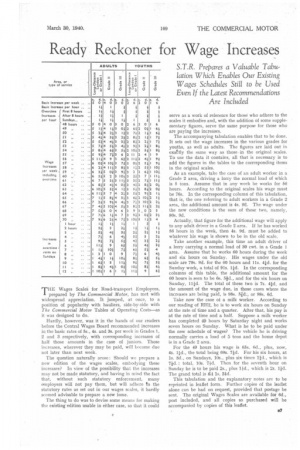Ready Reckoner for Wage Increases
Page 33

If you've noticed an error in this article please click here to report it so we can fix it.
S.T.R. Prepares a Valuable Tabulation Which Enables Our Existing Wages Schedules Still to be Used Even If the Latest Recommendations
Are Included
THE Wages Scales for Road-transport Employees, I prepared by The Commercial Motor, has met with widespread appreciation. It jumped, at once, to a position of popularity with hauliers, side-by-side with The Commercial Motor Tables of Operating Costs—as it was designed to do.
Hardly, however, was it in the hands of our readers before the Central Wages Board recommended increases in the basic rates of 5s., 4s. and 3s. per week in Grades 1, 2 and 3 respectively, with corresponding increases of half those amounts in the case of juniors. Those increases, wherever they may be paid, will become due not later than next week.
The question naturally arose ; Should we prepare a new edition of the wages scales, embodying these increases? In view of the possibility that the increases may not be made. statutory, and having in mind the fact that, without such statutory enforcement, many employers will not pay them, but will adhere to the statutory rates as set out in our wages scales, it hardly seemed advisable to prepare a new issue.
The thing to do was to devise some means for making the existing edition usable in either case, so that it could serve as a work of reference for those who adhere to the scales it embodies and, with the addition of some supplementary figures, serve the same purpose for those who are paying the increases.
The accompanying tabulation enables that to be done. It sets out the wage increases in the various grades for youths, as well as adults. The figures are laid out in exattly the same way as those • in the original scales. To use the data it contains, all that is necessary is to add the figures in the tables to the corresponding items in the original scales.
As an example, take the case of an adult worker in a Grade 2 area, driving a lorry the normal load of which is 5 tons. Assume that in any week he works for 56 hours. According to the original scales his wage must be 76s. In the corresponding column of this tabulation, that is, the one referring to adult workers in a Grade 2 area, the additional amount is 4s. 9d. The wage under the new conditions is the sum of those two, namely, 80s. 9d.
Actually, that figure for the additional wage will apply to any adult driver in a Grade 2 area. If he has worked 56 hours in the week, then 4s. 9d. must be added to whatever his wage is shown to be in the old scale.
Take another example, this time an adult driver of a lorry carrying a normal load of 30 cwt, in a Grade I area. Assume that he works 60 hours during the week and six hours on Sunday. His wages under the old scale are 79s. 9d. for the 60 hours and I ls. 41d. for the Sunday work, a total of 91s. lid. In the corresponding columns of this table, the additional amount for the 60 hours is seen to be Gs. Sid., and for the six hours on Sunday, hid. The total of these two is 7s. 4d, and the amount of the wage due, in those cases where the increases are being paid, is 98s. Sid., or 98s. 6d.
Take now the case of a milk worker. According to our reading of RI12, he is to work six hours on Sunday at the rate of time and a quarter. After that, his pay is at the rate of time and a half. Suppose a milk worker has completed 49 hours by Saturday night and works seven hours on Sunday. What is he to be paid under the new schedule of wages? The vehicle he is driving normally carries a load of 5 tons and the home depot is in a Grade 2 area.
For the 49 hours his wage is 65s. 6d., plus, now, 4s. lid., the total being 69s. 71d. For his six hours, at Is. 8d., on Sundays, 10s., plus six times lid., which is 71d.: total, 10s. 73el. Then for the seventh hour on Sunday he is to be paid 2s., plus lid., which is 2s. lid. The grand total is £4 is. 33d.
This tabulation and the explanatory notes are to be reprinted in leaflet form. Further copies of the leaflet alone can be had on request, provided that postage be sent. The original Wages Scales are available for 6d., post included, and all copies so purchased will be accompanied by copies of this leaflet.




























































